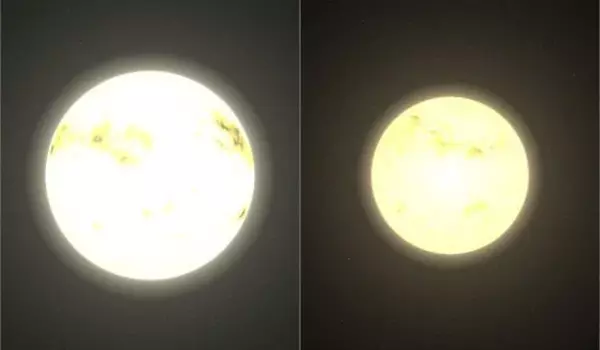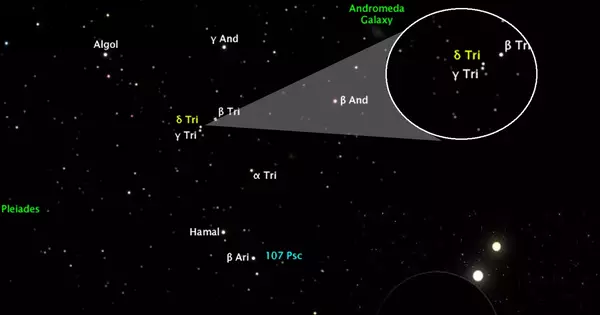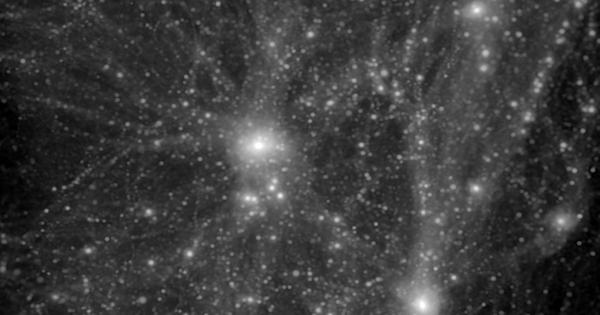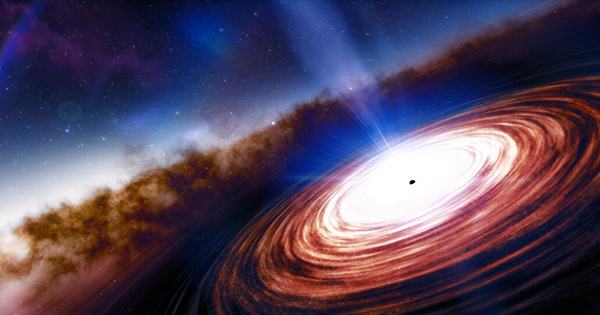Delta Trianguli, Latinized from Delta Tri, is a spectroscopic binary star system located in the constellation Triangulum about 35 light-years (11 pc) away. Because it is located north of the celestial equator, it is more visible from the northern hemisphere. The primary star is thought to be a yellow dwarf, while the secondary star may be an orange dwarf. It has an apparent magnitude of +4.87 and joins Gamma Trianguli and 7 Trianguli in an optical (line-of-sight) triple.
Delta Trianguli is a Spectroscopic Binary. It is not in the Solar System; there is only one star in the Solar System, and that is the Sun. There are no Exoplanets recorded on the site for the star, which is most likely the case. It is not part of the Triangulum constellation outline, but it is within its borders. The Delta Trianguli star’s spectral type (G0V) indicates that it is yellow. According to Hipparcos, the star has an estimated age of 8.50 billion years, but it could be as young as 4.80 to 11.30. It is a binary or multiple star system.
δ Trianguli is a double hypergiant star in the constellation of Triangulum. Its visual magnitude is 4.87. Because of its moderate brightness, δ Trianguli should be easily visible from locations with dark skyes, while it can be barely visible, or not visible at all, from skyes affected by light pollution. It is a visual double star which can be observed only with the help of very large telescopes.

Stellar components
The Delta Trianguli system is located about 35.4 light-years from Sol. It lies in the north central part of Constellation Triangulum, the Triangle – near Gamma and 7 Trianguli, slightly southeast of Beta Trianguli and northeast of Mothallah (Alpha Trianguli) and Hamal (Alpha Arietis). According to the Yale Bright Star Catalogue, 1991 5th Revised Edition notes entry for HR 660, the system is a member of the Zeta Herculis stellar moving group.
Delta Trianguli A is a main sequence star with the stellar classification G0V and a mass comparable to that of the Sun. The spectral characteristics of Delta Trianguli B’s smaller companion are not well determined because the close orbit makes observations difficult, with estimates ranging from G9V to K4V. The Delta Trianguli stars orbit their center of mass at a distance of 0.106 AU, which is almost certainly less than one AU. The orbital period is 10.02 days, and the orbital eccentricity is only 0.020. The orbit is inclined to the line of sight from Earth by about 167°.
Delta Trianguli A is a yellow-orange main sequence dwarf star with the spectral and luminosity type G0.5 Ve. It may have up to 109 percent of Sol’s mass, 98 percent of its mass, and 1.1 times its visual luminosity. Based on its abundance of iron, the star may only be 13 to 31 percent as enriched in elements heavier than hydrogen (“metallicity”) as Sol.
A 2008 search for a tertiary companion to this system using an adaptive optics system on the VLT was unsuccessful. An examination of the system in infrared light at 70 m reveals no excess emission that would otherwise indicate the presence of an orbiting dust disk.
















